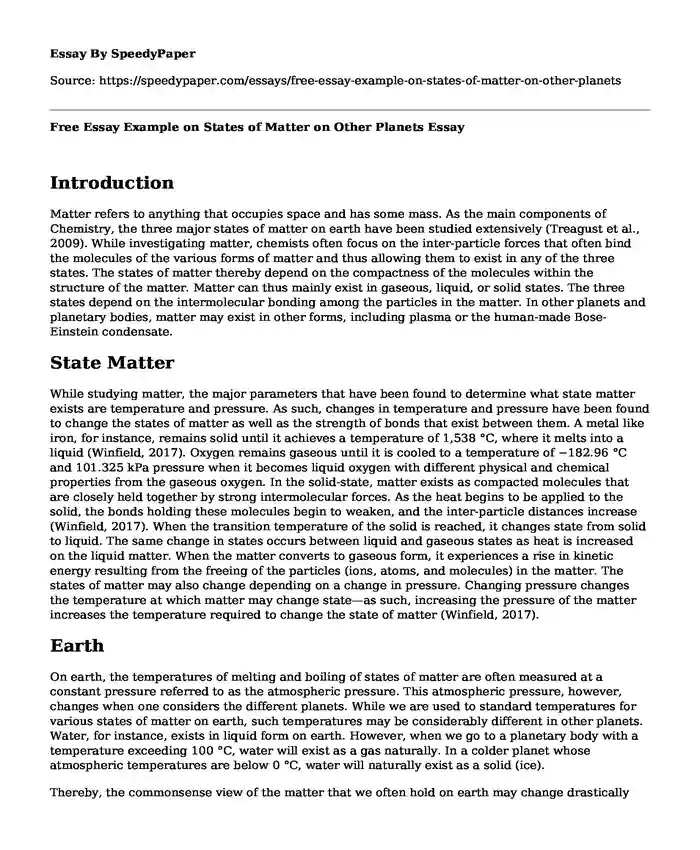Introduction
Matter refers to anything that occupies space and has some mass. As the main components of Chemistry, the three major states of matter on earth have been studied extensively (Treagust et al., 2009). While investigating matter, chemists often focus on the inter-particle forces that often bind the molecules of the various forms of matter and thus allowing them to exist in any of the three states. The states of matter thereby depend on the compactness of the molecules within the structure of the matter. Matter can thus mainly exist in gaseous, liquid, or solid states. The three states depend on the intermolecular bonding among the particles in the matter. In other planets and planetary bodies, matter may exist in other forms, including plasma or the human-made Bose-Einstein condensate.
State Matter
While studying matter, the major parameters that have been found to determine what state matter exists are temperature and pressure. As such, changes in temperature and pressure have been found to change the states of matter as well as the strength of bonds that exist between them. A metal like iron, for instance, remains solid until it achieves a temperature of 1,538 °C, where it melts into a liquid (Winfield, 2017). Oxygen remains gaseous until it is cooled to a temperature of −182.96 °C and 101.325 kPa pressure when it becomes liquid oxygen with different physical and chemical properties from the gaseous oxygen. In the solid-state, matter exists as compacted molecules that are closely held together by strong intermolecular forces. As the heat begins to be applied to the solid, the bonds holding these molecules begin to weaken, and the inter-particle distances increase (Winfield, 2017). When the transition temperature of the solid is reached, it changes state from solid to liquid. The same change in states occurs between liquid and gaseous states as heat is increased on the liquid matter. When the matter converts to gaseous form, it experiences a rise in kinetic energy resulting from the freeing of the particles (ions, atoms, and molecules) in the matter. The states of matter may also change depending on a change in pressure. Changing pressure changes the temperature at which matter may change state—as such, increasing the pressure of the matter increases the temperature required to change the state of matter (Winfield, 2017).
Earth
On earth, the temperatures of melting and boiling of states of matter are often measured at a constant pressure referred to as the atmospheric pressure. This atmospheric pressure, however, changes when one considers the different planets. While we are used to standard temperatures for various states of matter on earth, such temperatures may be considerably different in other planets. Water, for instance, exists in liquid form on earth. However, when we go to a planetary body with a temperature exceeding 100 °C, water will exist as a gas naturally. In a colder planet whose atmospheric temperatures are below 0 °C, water will naturally exist as a solid (ice).
Thereby, the commonsense view of the matter that we often hold on earth may change drastically when we enter atmospheres whose pressure and temperatures vary significantly from the temperature on earth. On the sun, for instance, the natural temperatures are so high that the matter in the sun exists in a state called plasma. The plasma state refers to the ultra-heated substance beyond the gas state (Winfield, 2017).
Conclusion
Thus, if a planetary body possesses significantly different atmospheric pressure and temperature, substances shall exist in different states of matter. Oxygen may, for instance, exist naturally in a liquid state in a planet that possesses an atmospheric temperature that is constantly maintained below −182.96 °C. It is thereby essential to note that states of matter may exist differently in different planets when their temperatures and pressures occur on one end of the transition point for the matter.
References
Treagust, D. F., Chandrasegaran, A. L., Crowley, J., Yung, B. H. W., Cheong, I. P.-A., & Othman, J. (2009). Evaluating Students’ Understanding of Kinetic Particle Theory Concepts Relating To The States Of Matter, Changes Of State And Diffusion: A Cross-National Study. International Journal of Science and Mathematics Education, 8(1), 141–164. https://doi.org/10.1007/s10763-009-9166-y
Winfield, R. D. (2017). The Physical States of Matter. Conceiving Nature after Aristotle, Kant, and Hegel, 233–271. https://doi.org/10.1007/978-3-319-66281-7_8.
Cite this page
Free Essay Example on States of Matter on Other Planets. (2023, Nov 10). Retrieved from https://speedypaper.com/essays/free-essay-example-on-states-of-matter-on-other-planets
Request Removal
If you are the original author of this essay and no longer wish to have it published on the SpeedyPaper website, please click below to request its removal:
- Cleaning System for PV Panels Problem Statement Example
- Essay Example for Your Use: Urban Livability
- Essay Sample: Eugenics in Popular Culture Today
- Paper Example on Military Intervention in the Post-Cold War Era
- Essay Sample on Evolution of Disaster Recovery Plans
- Essay Example: The Shape of the Earth: Could It Be Spherical or Flat?
- Free Paper Sample on Perioperative Risk Assessment
Popular categories





